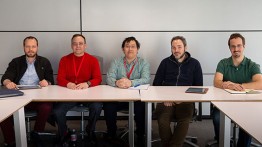Cooper Co-Develops Plasma Blaster
POSTED ON: May 13, 2019

From left to right: Professor Dirk Martin Luchtenburg, Frank A. Magnotti Sr. (ME'82, M.Eng'83), Dachi Tan, Professor Philip Yecko, and Frank Magnotti Jr.
A group of researchers from the Albert Nerken School of Engineering have begun a 2-year partnership with Petram Technologies, a company developing safer, more environmentally friendly demolition and excavation methods through plasma blasting.
Dirk Martin Luchtenburg, assistant professor of mechanical engineering, and Philip Yecko, associate professor of physics, along with engineering master’s student Dachi Tan, are investigating commercial applications for Petram’s “plasma blasting” system, offering an innovative alternative to current rock and concrete fracturing methods. The partnership provides a full-tuition scholarship for Dachi to complete his master’s thesis.
Teaming up with experts from The Cooper Union was a natural choice for Petram’s CEO, Cooper alumnus Frank A. Magnotti Sr. ME'82, M.Eng'83, whose wife and daughter are also both graduates of Cooper. “Even though Cooper Union didn’t have the specific and prior experience in plasma blasting, I knew from my experience that if you start with very intelligent and passionate people, you can create some pretty great things.” Magnotti explains. His son, Frank Magnotti Jr., Petram’s vice president of engineering and product management, is working with the team as well.
The patent for Petram’s blasting technology came about through a NASA-funded project at Auburn University, where researchers were asked to develop an energy efficient means of excavating rock in extreme environments, such as the moon or Mars. Their solution used electro-hydraulic fracturing, a process that applies electrical voltage to a small amount of water and generates a plasma channel of thermodynamic energy strong enough to blast apart rock. By working with The Cooper Union, Petram now hopes to further test and model the commercial viability of this technology, which uses less energy than conventional machinery and is less disruptive to surrounding structures.
The Cooper team says they were drawn to the research project’s unique practical and theoretical problems. “First, we found out Frank was blowing stuff up, so that sounded pretty cool,” jokes Luchtenburg. “But as we learned more about the project, it became apparent that this was a really interesting modelling challenge.”
“I’m a physicist, and this problem is wonderfully rich in physics,” Professor Yecko explains. “It has everything from electromagnetism, to plasmas, to shockwaves and hydrodynamics. It’s a problem that’s very application driven. We have to take into account real-world constraints and goals.”
The researchers will test the technology in blasting experiments at facilities in Alabama and New Jersey and hope to begin commercialization by the end of their 2-year contract. “This is a great opportunity for Cooper to get involved with a cutting-edge technology,” says Magnotti Sr., who hopes the partnership can continue beyond the two years. “It looks like it has a lot of long-term promise. We are granting a full-tuition scholarship for a master’s student with the hope that this would eventually include multiple master’s students and some undergraduates as well.”
For his part, Dachi is excited about gaining experience outside the scope of a classroom curriculum. “In a standardized course you wouldn’t get to learn anything related to plasma blasting.”
“We were so pleased to arrive at this partnership with Frank Magnotti and Petram Technologies,” says Anita Raja, Associate Dean of Research and Graduate Programs in the School of Engineering. “It is a very strong example of how collaborations between Cooper’s School of Engineering, our alumni, and industry can create meaningful opportunities for graduate-level research to investigate and seek state-of-the-art solutions.”
“Being on the cutting edge of a new application for this under-leveraged technology, I find this really exciting—it’s paving a new path forward,” says Frank Jr.
Professor Yecko chimes in, “Or unpaving it."




